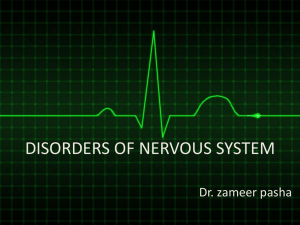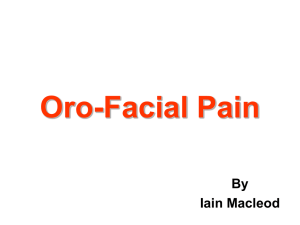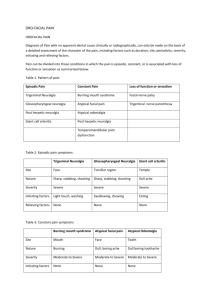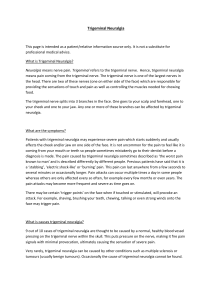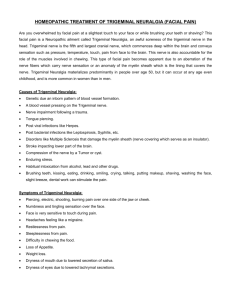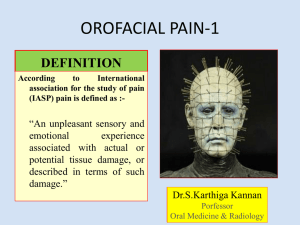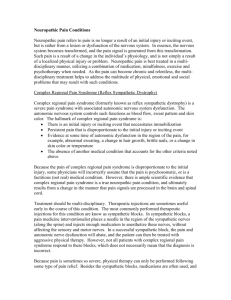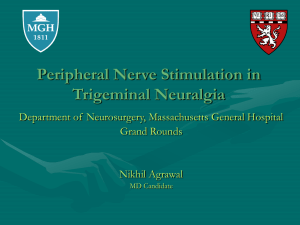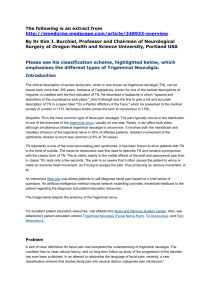Trigeminal Neuralgia Fact Sheet
advertisement
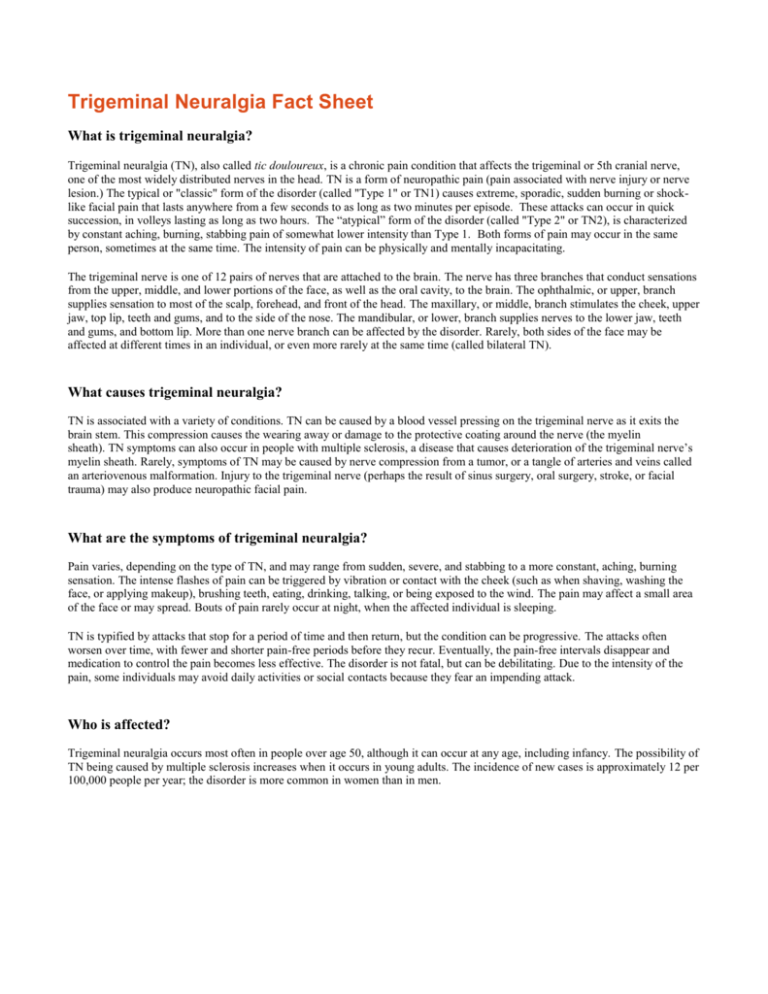
Trigeminal Neuralgia Fact Sheet What is trigeminal neuralgia? Trigeminal neuralgia (TN), also called tic douloureux, is a chronic pain condition that affects the trigeminal or 5th cranial nerve, one of the most widely distributed nerves in the head. TN is a form of neuropathic pain (pain associated with nerve injury or nerve lesion.) The typical or "classic" form of the disorder (called "Type 1" or TN1) causes extreme, sporadic, sudden burning or shocklike facial pain that lasts anywhere from a few seconds to as long as two minutes per episode. These attacks can occur in quick succession, in volleys lasting as long as two hours. The “atypical” form of the disorder (called "Type 2" or TN2), is characterized by constant aching, burning, stabbing pain of somewhat lower intensity than Type 1. Both forms of pain may occur in the same person, sometimes at the same time. The intensity of pain can be physically and mentally incapacitating. The trigeminal nerve is one of 12 pairs of nerves that are attached to the brain. The nerve has three branches that conduct sensations from the upper, middle, and lower portions of the face, as well as the oral cavity, to the brain. The ophthalmic, or upper, branch supplies sensation to most of the scalp, forehead, and front of the head. The maxillary, or middle, branch stimulates the cheek, upper jaw, top lip, teeth and gums, and to the side of the nose. The mandibular, or lower, branch supplies nerves to the lower jaw, teeth and gums, and bottom lip. More than one nerve branch can be affected by the disorder. Rarely, both sides of the face may be affected at different times in an individual, or even more rarely at the same time (called bilateral TN). What causes trigeminal neuralgia? TN is associated with a variety of conditions. TN can be caused by a blood vessel pressing on the trigeminal nerve as it exits the brain stem. This compression causes the wearing away or damage to the protective coating around the nerve (the myelin sheath). TN symptoms can also occur in people with multiple sclerosis, a disease that causes deterioration of the trigeminal nerve’s myelin sheath. Rarely, symptoms of TN may be caused by nerve compression from a tumor, or a tangle of arteries and veins called an arteriovenous malformation. Injury to the trigeminal nerve (perhaps the result of sinus surgery, oral surgery, stroke, or facial trauma) may also produce neuropathic facial pain. What are the symptoms of trigeminal neuralgia? Pain varies, depending on the type of TN, and may range from sudden, severe, and stabbing to a more constant, aching, burning sensation. The intense flashes of pain can be triggered by vibration or contact with the cheek (such as when shaving, washing the face, or applying makeup), brushing teeth, eating, drinking, talking, or being exposed to the wind. The pain may affect a small area of the face or may spread. Bouts of pain rarely occur at night, when the affected individual is sleeping. TN is typified by attacks that stop for a period of time and then return, but the condition can be progressive. The attacks often worsen over time, with fewer and shorter pain-free periods before they recur. Eventually, the pain-free intervals disappear and medication to control the pain becomes less effective. The disorder is not fatal, but can be debilitating. Due to the intensity of the pain, some individuals may avoid daily activities or social contacts because they fear an impending attack. Who is affected? Trigeminal neuralgia occurs most often in people over age 50, although it can occur at any age, including infancy. The possibility of TN being caused by multiple sclerosis increases when it occurs in young adults. The incidence of new cases is approximately 12 per 100,000 people per year; the disorder is more common in women than in men. How is trigeminal neuralgia treated? Medications Anticonvulsant medicines—used to block nerve firing—are generally effective in treating TN1 but often less effective in TN2. These drugs include carbamazepine, oxcarbazepine, topiramate, gabapentin, pregabalin, clonazepam, phenytoin, lamotrigine, and valproic acid. Tricyclic antidepressants such as amitriptyline or nortriptyline can be used to treat pain. Common analgesics and opioids are not usually helpful in treating the sharp, recurring pain caused by TN1, although some individuals with TN2 do respond to opioids. Eventually, if medication fails to relieve pain or produces intolerable side effects such as cognitive disturbances, memory loss, excess fatigue, bone marrow suppression, or allergy, then surgical treatment may be indicated. Since TN is a progressive disorder that often becomes resistant to medication over time, individuals often seek surgical treatment. Surgery Several neurosurgical procedures are available to treat TN, depending on the nature of the pain; the individual’s preference, physical health, blood pressure, and previous surgeries; presence of multiple sclerosis, and the distribution of trigeminal nerve involvement (particularly when the upper/ophthalmic branch is involved). Some procedures are done on an outpatient basis, while others may involve a more complex operation that is performed under general anesthesia. Some degree of facial numbness is expected after many of these procedures, and TN will often return even if the procedure is initially successful. Depending on the procedure, other surgical risks include hearing loss, balance problems, leaking of the cerebrospinal fluid (the fluid that bathes the brain and spinal cord), infection, anesthesia dolorosa (a combination of surface numbness and deep burning pain), and stroke, although the latter is rare. Surgical treatment for TN2 is usually more problematic than for TN1, particularly where vascular compression is not detected in brain imaging prior to a proposed procedure. Many neurosurgeons advise against the use of MVD or rhizotomy in individuals for whom TN2 symptoms predominate over TN1, unless vascular compression has been confirmed. MVD for TN2 is also less successful than for TN1. Where can I get more information? For more information on neurological disorders or research programs funded by the National Institute of Neurological Disorders and Stroke, contact the Institute's Brain Resources and Information Network (BRAIN) at: BRAIN P.O. Box 5801 Bethesda, MD 20824 800-352-9424 http://www.ninds.nih.gov Information also is available from the following organizations: National Institute of Dental and Craniofacial Research (NIDCR) National Institutes of Health, DHHS 31 Center Drive, Room 5B-55 Bethesda, MD 20892 nidcrinfo@mail.nih.gov http://www.nidcr.nih.gov Tel: 301-496-4261 TNA -- Facial Pain Association (formerly the Trigeminal Neuralgia Association) 408 W. University Avenue Suite 602 Gainesville, FL 32601 info@fpa-support.org http://www.fpa-support.org/ Tel: 352-384-3600 800-923-3608 Fax: 352-331-3606 Taken From: http://www.ninds.nih.gov/disorders/trigeminal_neuralgia/detail_trigeminal_neuralgia.htm

